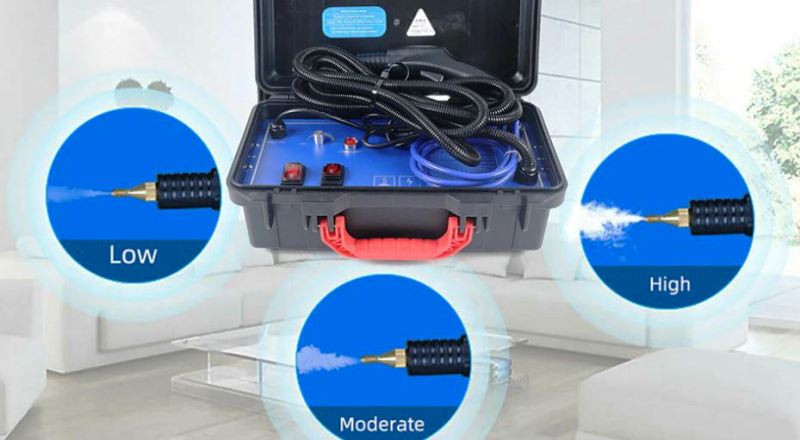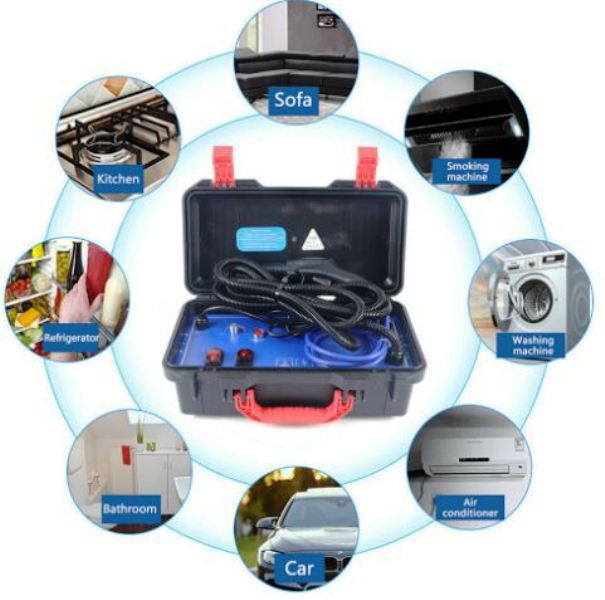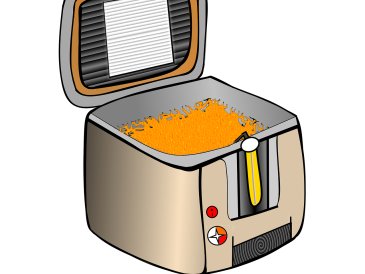How to Choose Your Steam Cleaner
Summary
– Criteria for choosing a steam cleaner
– Steam cleaner flow rate
– Steam cleaner pressure
– Steam cleaner autonomy
– Materials and options of the tank
– Number of decibels emitted
– Energy consumption of a steam cleaner
– Safety of the cleaner
– Ergonomics
– Steam cleaners’ comparison
It is essential to assess a steam cleaner’s performance in terms of power and autonomy to ensure that it will complete the cleaning task you require. Let’s see closer below about how to evaluate the performance of a steam cleaner.
Criteria for choosing a steam cleaner
The different criteria for evaluating the performance of a steam cleaner are:
- the steam flow (g/min): it is better to choose an adjustable flow;
pressure (bar): from 4 bars;
- the power (Watt): the more powerful the steam cleaner, the faster the water heats up, but the more energy it consumes;
- the construction material of the tank: stainless steel is preferred;
- the capacity of the tank: from 0.50 to 2 liters;
- the heating time: as short as possible;
- autonomy: from 10 to 50 minutes approximately;
- Noise level (dB): ask a dealer or the manufacturer;
- energy consumption: depends on the power of the heating elements;
- safety: make sure that the cap cannot open if there is still pressure inside;
- Ergonomics: sufficiently long cables and hoses, straps, good quality wheels, and a set that is not too heavy.
Steam cleaner flow rate
The steam flow rate is the speed at which the steam passes through the cleaner to reach the surface to be cleaned. Steam flow is measured in g/min. The higher the steam flow rate, the more efficient the unit is.
If you are using steam on a fragile floor, it is best not to use too much steam as this can damage the surface. It is best to choose a steam cleaner with an adjustable flow rate. The steam flow rate varies from 0 to 115 g/min :
– If you want to clean carpets and hard floors, don’t hesitate to use a flow rate of 70 g/min or more.
– If you want to clean laminate floors or fragile tiles, consider choosing a model with an adjustable flow rate to preserve your floors.
Note: Manufacturers are not required to provide this information, and it is only available on specific models.
The pressure of the cleaner

The pressure of a steam cleaner represents the force exerted by the steam projected to loosen the dirt right down to the depths of the surface. This pressure is measured in bar:
– The pressure can vary from 3 to 6 bars. For a steam cleaner to be effective, it must have a pressure of at least 4 bars.
– If it is a small steam cleaner, a pressure of 3.5 bars has no impact on the quality of cleaning.
– The higher the pressure, the faster you will see the dirt disappear without effort.
Autonomy of the steam cleaner
The autonomy of a steam cleaner depends on several factors:
– the volume of the tank,
– the autonomy :
◦ of the battery (if the device is wireless),
◦ the self-filling, which consists in replenishing the steam cleaner with water continuously,
– the heating time of the tank.
The volume of the tank
Apart from the models with unlimited autonomy, the autonomy of a steam cleaner depends, among other things, on the volume of water it can accommodate. The steam cleaner must be able to perform its cleaning work without interruption.
It can be annoying to be interrupted when the tank is empty, especially if the heating time is long.
To avoid this type of inconvenience, evaluate your needs in terms of the surface to be cleaned.
The water requirements differ according to the surface to be cleaned:
– For a small apartment: 0.50 to 0.75 liter.
– For a house: up to 2 liters or unlimited.
Battery life
Some steam cleaners are cordless, powered by a battery.
It is interesting to know how long you can use the device before being discharged. On average, cordless steam cleaners are autonomous for 20 minutes, the weakest 10 minutes, and the most powerful 40 minutes.
Note: the autonomy of a battery decreases as the device gets older.
Unlimited autonomy: self-refilling
The most sophisticated models include a self-filling system that continuously replenishes the steam cleaner with water. This way, you don’t have to interrupt your cleaning.
The heating time of the water
The heating time is when the resistors transform the water into steam, i.e., at 120°C. In general, the heating time does not exceed about ten minutes.
A classic steam cleaner with 1500 watt resistors will take about ten minutes to transform water into steam. On the other hand, if the model is equipped with a 2,000-watt resistance, the water will heat up twice as fast.
Good to know: Of course, it is convenient to have your steam cleaner as quickly as possible. However, the more powerful the resistors, the more energy the steam cleaner will consume.
Materials and tank options
Here are the things to look out for when it comes to tank design:
– To extend the life of your unit, choose a stainless steel tank.
– If your local water is hard, use an anti-scale product or a built-in descaling system.
– Another thing to watch out for is the soundproofing of the tank. The noise emitted by the appliance comes from its ability to muffle (silence) it in the tank. Some models are equipped with a noise reduction pump.
Number of decibels emitted
Like any electrical appliance, a steam cleaner makes noise. When steam is projected onto a surface, it can make an unpleasant whistling sound. The noise emitted by the cleaner is expressed in decibels, and it is not mandatory to display the number of decibels.
Good to know: don’t hesitate to ask a salesperson: a difference of three decibels can translate into twice the sound volume.
Energy consumption of a steam cleaner
Although a steam cleaner is considered to be environmentally friendly, in the sense that it uses very little water and no detergent, it does have resistors that heat the water in the tank:
– The energy consumption of these resistances can vary.
– The display of the energy class is not mandatory.
Therefore, we recommend that you ask the manufacturer or the retailer for this information.
Safety of the cleaner
A steam cleaner is an appliance that heats up to 200°C, blasts moist air into the atmosphere, and, of course, uses electricity. It should be used with care, especially if children are around.
Safety rules to follow with a steam cleaner
The cable:
– Connect the cable to a properly grounded outlet,
– do not pull on the cable to unplug it,
– do not let the cable come into contact with water.
The tank:
– If the tank leaks, do not use the steam cleaner;
– allow the steam cleaner to cool before touching it for storage;
– to open the tank cap, wait for the steam cleaner to cool down;
– If you still need to handle the steam cleaner while it is hot, use heavy gloves (oven mitts);
– keep the unit out of the reach of children;
– Do not leave the unit unattended.
Important safety features
– Safety cap: prevents the machine from opening if there is still pressure in the tank.
– The child lock: this is a small button located on the handle of the device. Once it is activated, the steam jet is blocked.
Ergonomics
It is important to have a good grip on the device: the handle must be soft to the touch, the cables and hoses long enough, the wheels of good quality, and the tank must not be too heavy.
Indeed, you must be able to lift a steam cleaner to reach an object in height, for example, when cleaning the stairs.
Smaller models are equipped with a strap so that you can hang them on the shoulder. The device’s weight is essential in making your choice, especially for the largest tanks that can reach 10 kg.
Steam cleaners comparison
Below is a list of criteria to consider when selecting the proper model:
|
Steam cleaner |
Entry-level |
Top of the range |
|
|---|---|---|---|
|
Steam flow rate |
35 gr/min not adjustable |
Adjustable from 0 to 115 gr/min |
|
|
Pressure |
4 bars |
5 bars |
|
|
Autonomy |
Volume of the tank |
0,3 l |
1,2 l |
|
Tank heating time |
2 min (1 400 Watts) |
1 100 Watts |
|
|
Total autonomy |
Not specified |
Unlimited |
|
|
Tank design material |
Not specified |
Aluminum alloy |
|
|
Safety |
Automatic tank opening and closing |
– Steam function deactivation button. – Anti-spill safety device. |
|
|
Weight |
Approximately 4 kg |
From 5 to 9 kg |
|





